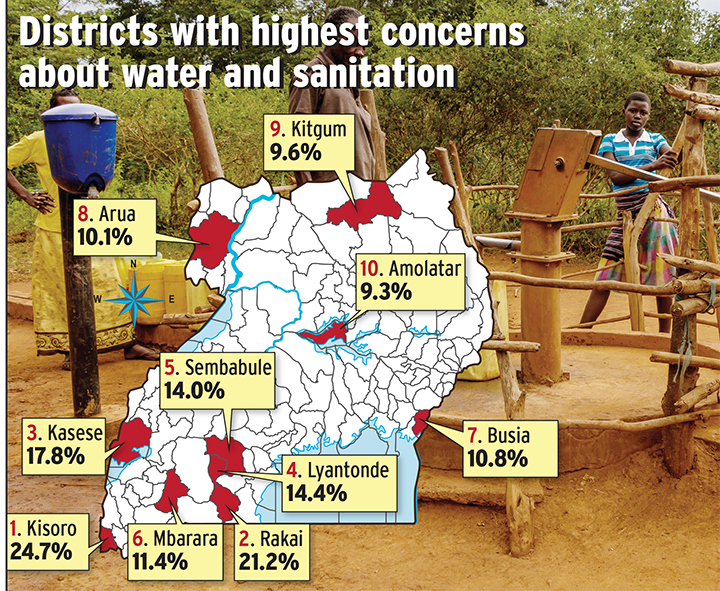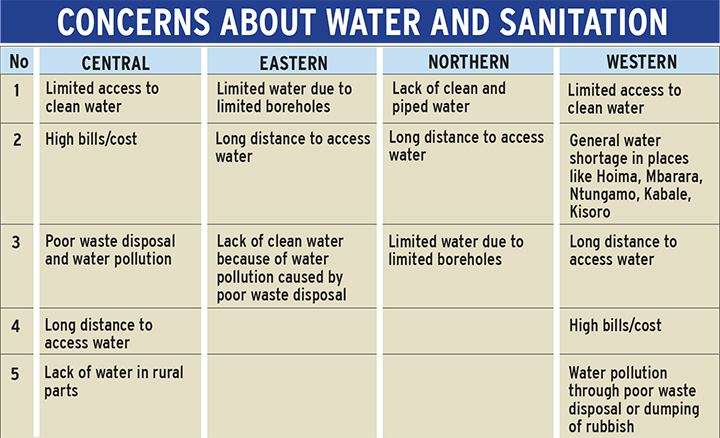Citizens' Manifesto: Ugandan voters want more access to safe water
Oct 31, 2020
In an opinion poll conducted by Vision Group in March, ahead of next year’s general election, Ugandans shared 20 of their most pressing concerns. Access to safe water was number six among the most pressing issues mentioned.

Imagine going through a day without water. As you try to wrap your head around it, in many parts of Uganda, a lot of people have no access to clean and safe water for daily consumption.
Water is critical for human survival; hence many people trek several kilometres to get clean water.
In Kotido municipality, residents wake up as early as 4:00am to fetch water, but sometimes do not get any.
Beatrice Yei, a resident of East division in Kotido, says the town experiences slow water flow and that at times there is no water at all, especially in high altitude areas.
"It starts fl owing at 7:00am and by 9:00am, the taps run dry. Sometimes we spend six hours in the queue for a chance to collect water," she says.
The water crunch surfaced in Kotido after local water sources started to run dry with the onset of the dry season.
Samson Kaile, another resident, says they have now resorted to drawing water from swamps and other dirty sources, which is dangerous to people's health.
"It is a health concern, we need water running in our homes and health facilities, or else we will contract diseases. The swamps are also far away," Kaile says.
Romano Kapel, the Kotido district education officer, says the situation is not different in schools, where learners walk long distances to get water.
"There are several schools without safe water. Learners walk for several kilometres to get water," Kapel says.
He cites Panyangara Primary School which depends a borehole located about a kilometre away.
"We are water-stressed. We should be supported to start water harvesting. Communities are struggling, although it is not as bad as five years ago," Kapel says.
Pressing need
According to a Vision Group public opinion poll carried earlier this year in 45 districts, respondents highlighted water and sanitation as one of their most pressing concerns.
Water and sanitation ranked sixth out of 20 issues, with 5.8% of the 5,987 respondents saying it is a major issue.
The survey shows that the majority, or 14% of Ugandans, consider health the most pressing concern, followed by poverty, 10.1%, education, 9.3%, road network and transport issue, 8.9% and national security, 7%.
Concerns about water and sanitation were mostly highlighted in the western region, where 6% of the voters identified it as a major setback, followed by the northern region with 5.9% response.
The central and eastern regions follow with 5.7% and 5.5%, respectively.

The respondents were randomly asked to state their most outstanding concerns, in their localities without giving them a list of issues to choose from.
In the central region, where the issue of water and sanitation ranked highly compared to other regions, respondents pointed to issues of limited access to clean water, long distance to access water and high water bills.
In areas such as Hoima, Mbarara, Ntungamo and Kabale, general water shortage was the biggest issue.
Water pollution through poor waste disposal or dumping of rubbish and long distance to water sources cut across all the regions.
Respondents from northern and eastern Uganda mentioned lack of boreholes.
Arua ranks among the top five districts where poor access to water and sanitation was most prominent in the countrywide survey that involved interviews with 5,987 respondents.
In Arua district, located in northern Uganda, respondents indicated water and sanitation as the third biggest concern at 11.1%, just below health, 15.1% and poverty at13.9%.
Lack of water supply has pushed residents to depend on water vendors to overcome the challenge.
Sharifa Hamida, a resident of Arua town, says some people have taken advantage of the situation and are selling water for as much as sh1,000 for a 20-litre jerrycan.
"At the public stand, a jerrycan costs sh100, but there is no water. So people fetch water from boreholes and sell to town dwellers expensively," Hamida says.
Kampala shock
The situation is not different in Kyebando, Kampala, where residents walk for about a kilometre to get water.
"It is like we are not in Kampala. We have to walk to the well near the Northern Bypass to get water. The bypass is about a kilometre from our homes," says Lazarus Kanyike, the area chairperson.
In Abim district, lack of water is still a big challenge. People have to move long distances to get clean water.

Those who cannot manage to move far settle for dirty water in ponds and wells.
It is common to see women and children scooping stagnant water from puddles off the road.
Respondents, especially in northern Uganda, expressed concern over poor waste disposal, where rubbish, such as plastics, polythene bags and glass is dumped anywhere.
Uganda has 133,954 domestic water points, which serve a total of 27,593,137 people — 22,565,611 in rural areas.
An additional 5,312 sources have been nonfunctional for more than five years and are considered abandoned.
Uganda has 1,211 piped schemes. At least 20 districts out 146 have access to safe water, with rates standing at 50% and below.
The access rates in Kyegegwa vary from 17 % in Ruyonza sub-county to 63 % in Hapuuyo sub-county, making it one of the worst districts in terms of water coverage, with 32%.
While universal access to clean water and sanitation is one of the 17 global goals that make up the 2030 agenda for sustainable development, water scarcity affects more than 40% of the world's population.
In 2016, the Government had increased access to safe water from crisis levels in most parts of the country to 65% in rural and 72% in urban areas.
Sanitation levels, such as pit-latrine coverage, have also improved to a national average of 74%.
Focus on access to safe water and sanitation will continue with the aim of increasing piped water coverage in both urban and rural areas.
In Kampala, the Governmenthas embarked on the Katosi water project, which Eng. Mahmood Lutaaya, the National Water and Sewerage Corporation (NWSC) Kampala general manager, says will address the water shortage.
"We are experiencing a challenge because the water we pump cannot meet demand," Lutaaya says.
Whereas NWSC produces 240 million litres of water per day, peak demand is 300 million litres per day.
Lutaaya explains that to bridge the shortfall, NWSC is undertaking the construction of a 240 million litre per day capacity water treatment plant in Katosi, east of Kampala.
"The first phase will be completed in January 2021. We will deliver 160 million litres of water per day and by February, we shall have this water," Lutaaya says.
Women, children Bear the Brunt
In most cases the task of providing water for households falls excessively to women and girls, especially in rural areas.
When students are freed from gathering water, they return to class.
With proper and safe latrines, girls stay in school through their teenage years.
According to data from the Ministry of Water and Environment, majority of the people in Arua get water from deep boreholes (57%), followed by protected spring wells at 34%, shallow wells account for 7%, while public taps cover 2%.
With a population of 753,237, Arua has 2,230 domestic water points, which serve a total of 570,100 people — 508,580 in rural areas.
At least 363 water points have been nonfunctional for over five years and are considered abandoned. Arua has four piped schemes and district access is 76%.
Funding gaps
The Ntoroko district chief administrative officer, Anselm Kyaligonza, notes that addressing water-related issues cannot be done in one day.
Much of the funding is from local government at 38% and NGOs at 27.4%, closely followed by the Government at 24.2%.
"The Government should give more money for provision of safe water to local governments," Kyaligonza says.
Water minister Sam Cheptoris, agrees that the sector needs more funding.
"The sector still has huge funding gaps. We need about sh5 trillion annually and sh10 trillion by 2023 if we are to meet our set goals amidst the ever-growing population and service delivery demands," Cheptoris says.
The numbers
According to WaterAid, eight million Ugandans lack access to safe water, while 27 million do not have improved sanitation facilities.
Around the world, 2.2 billion people lack access to adequate water supplies and close to 4.2 billion people suffer from the consequences of poor sanitation.
The average access rates in Uganda stand at 68%. The Government is, however, not sitting.
New 35 solar-powered mini-piped water schemes have been constructed so far.
In the financial year 2019/20, a total of 608 new boreholes were constructed and 1,096 rehabilitated.
A total of 57 piped water systems with 587 taps and 90 protected spring wells were constructed.
The Government also completed construction of 16 water supply systems in small towns with 383 public stands.
